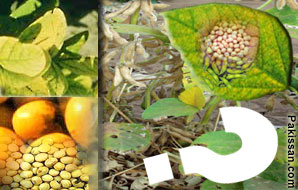|
What's wrong with my soybeans?
Some tips to help you with do-it-yourself field diagnosis on yellowing plants
Your beautiful green field of soybeans has suddenly started to sprout yellow leaves, and you would like to sort out the cause. But field diagnosis is a complex task because many problems share similar symptoms. Even worse, we tend to look for the problems we are most familiar with, so a pathologist will see only disease, and an agronomist may see only nutrient deficiencies or herbicide damage.
Careful observation, though, can help you sort out the possible causes, or at least help you describe the symptoms clearly to an experienced agronomist. It is important to remember that the symptoms you see are only the plant's reaction to what is happening to it, and may not be the root cause of the problem.
A nutrient deficiency, for example, may be caused by a lack of nutrients in the soil, by poor root growth in a compacted soil, or by reduced root volume from a disease or insect feeding. The two main things you will need to look for are where on the plant the yellowing is occurring, and the pattern of yellowing on the leaves. Of course, having an accurate field history makes the job much easier as well. The following is a key to some of the most common causes of leaf discolouration, with some hints on how to confirm whether you have identified the problem correctly. It is not a complete list, but should be a starting point.
Yellowing primarily on bottom leaves
- Entire leaf is yellow. General yellowing of the leaves, gradually spreading from the bottom towards the top, usually indicates a nitrogen deficiency. The most common cause of N deficiency in soybeans is nodulation failure, so check the roots for nodules. If there are few or no nodules, an application of nitrogen fertilizer may be required. If nodules are developing, the plant will most likely grow out of it.
- Yellow spots or blotches on margin of leaf. Usually indicates potash deficiency. The margins of the leaves will eventually turn brown and dry. Can be confirmed with a tissue test or soil test.
- Yellow or brown spots scattered over bottom leaves. Soil that contains a pre-emergent herbicide like metribuzin or linuron can cause burning when splashed onto the leaves.
- Yellow spots, or general yellowing, with brown specks inside. Disease which favours moist conditions, like Brown Spot. Confirm by sending samples to diagnostic lab, or by placing leaf samples in a plastic bag. The increased humidity will encourage the development of any disease organisms.
Yellowing primarily on top leaves
- Leaf blade is yellow while veins stay dark green. This distinctive pattern is diagnostic of manganese deficiency. You can confirm this by spraying some manganese sulphate solution on a small area. The plants should green up with 24 hours.
- Yellow or brown spots scattered over top leaves. Most likely injury from a post-emerge herbicide, or from the oil used with the herbicide. Exact symptoms will vary with the active ingredients and the weather conditions at the time of spraying.
- Yellowing of leaf margins. Could be a symptom of a stem disease, like Diaporthe tip blight, if it is occurring later in the season. Look for lesions on the stem where the leaves attach.
Yellowing in middle of plant
- Leaf blade is yellow while veins stay dark green. This indicates that the plant had suffered from manganese deficiency at an earlier stage, and has now grown out of it. This commonly occurs when there is a stretch of cool, dry weather, followed by a rainfall. The moisture encourages the mineralization of more manganese out of the organic matter in the soil.
Entire plant shows yellowing
- Whole leaf is yellow. Sulphur deficiency will cause a general yellowing over the whole plant, but it is uncommon in Southern Ontario. This diagnosis you would definitely want to have confirmed by tissue analysis.
- Discoloured spots and blotches. This most likely indicates a foliar disease of some sort. Consult a plant disease guide, or send samples to the diagnostic lab. BF Stratford-based Keith Reid is Crop Fertility Specialist with the Ontario agriculture ministry.
|
Pakissan.com;
|